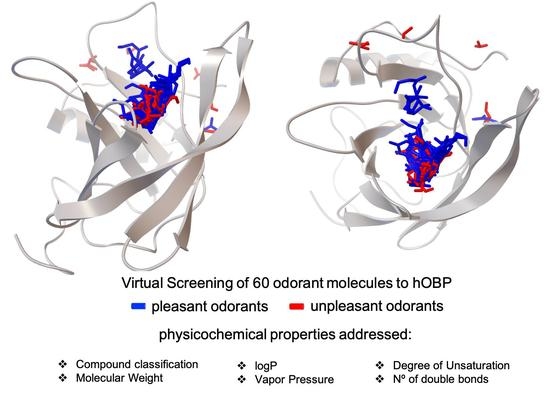The Structural Properties of Odorants Modulate Their Association to Human Odorant Binding Protein
Abstract
:1. Introduction
2. Methods
2.1. Human Odorant Binding Protein Structure
2.2. Molecular Dynamics Simulations and Choice of hOBP Conformation
2.3. Odorant Molecules Setup
2.4. Principal Component Analysis
2.5. Virtual Screening of Odorant Molecules
3. Results and Discussion
4. Conclusions
Supplementary Materials
Author Contributions
Funding
Institutional Review Board Statement
Informed Consent Statement
Data Availability Statement
Acknowledgments
Conflicts of Interest
Abbreviations
| hOBP | Human odorant-binding protein |
| PCA | Principal component analysis |
| OR | Olfactory receptor |
| MD | Molecular dynamics |
| MW | Molecular weight |
| Vp | Vapor pressure (volatility) |
| logP | Partition coefficient (hydrophobicity level) |
| N°DB | Number of double bonds |
| DoU | Degree of unsaturation |
References
- Olender, T.; Keydar, I.; Pinto, J.M.; Tatarskyy, P.; Alkelai, A.; Chien, M.-S.; Fishilevich, S.; Restrepo, D.; Matsunami, H.; Gilad, Y.; et al. The human olfactory transcriptome. BMC Genom. 2016, 17, 1–18. [Google Scholar] [CrossRef] [Green Version]
- Persuy, M.-A.; Sanz, G.; Tromelin, A.; Thomas-Danguin, T.; Gibrat, J.-F.; Pajot-Augy, E. Mammalian olfactory receptors: Molecular mechanisms of odorant detection, 3D-modeling, and structure–activity relationships. Prog. Mol. Biol. Transl. Sci. 2015, 130, 1–36. [Google Scholar] [CrossRef]
- Vidic, J.; Grosclaude, J.; Monnerie, R.; Persuy, M.-A.; Badonnel, K.; Baly, C.; Caillol, M.; Briand, L.; Salesse, R.; Pajot-Augy, E. On a chip demonstration of a functional role for odorant binding protein in the preservation of olfactory receptor activity at high odorant concentration. Lab Chip 2008, 8, 678–688. [Google Scholar] [CrossRef]
- Wade, F.; Espagne, A.; Persuy, M.-A.; Vidic, J.; Monnerie, R.; Merola, F.; Pajot-Augy, E.; Sanz, G. Relationship between homo-oligomerization of a mammalian olfactory receptor and its activation state demonstrated by bioluminescence resonance energy transfer. J. Biol. Chem. 2011, 286, 15252–15259. [Google Scholar] [CrossRef] [Green Version]
- Da Silva, C.M.P.M.; Matamá, M.T.; Azoia, N.G.; Mansilha, C.; Casal, M.; Cavaco-Paulo, A. Odorant binding proteins: A biotechnological tool for odour control. Appl. Microbiol. Biotechnol. 2013, 98, 3629–3638. [Google Scholar] [CrossRef] [Green Version]
- Gonçalves, F.; Ribeiro, A.; Silva, C.; Cavaco-Paulo, A. Biotechnological applications of mammalian odorant-binding proteins. Crit. Rev. Biotechnol 2021, in press. [Google Scholar] [CrossRef]
- Pelosi, P.; Zhu, J.; Knoll, W. Odorant-binding proteins as sensing elements for odour monitoring. Sensors 2018, 18, 3248. [Google Scholar] [CrossRef] [Green Version]
- Pelosi, P.; Mastrogiacomo, R.; Iovinella, I.; Tuccori, E.; Persaud, K. Structure and biotechnological applications of odorant-binding proteins. Appl. Microbiol. Biotechnol. 2014, 98, 61–70. [Google Scholar] [CrossRef] [PubMed]
- Gonçalves, F.; Ribeiro, A.; Silva, C.; Cavaco-Paulo, A. Release of fragrances from cotton functionalized with carbohydrate-binding module proteins. ACS Appl. Mater. Interfaces 2019, 11, 28499–28506. [Google Scholar] [CrossRef]
- Gonçalves, F.; Castro, T.G.; Azoia, N.G.; Ribeiro, A.; Silva, C.; Cavaco-Paulo, A. Two engineered OBPs with opposite temperature-dependent affinities towards 1-aminoanthracene. Sci. Rep. 2018, 8, 1–12. [Google Scholar] [CrossRef]
- Gonçalves, F.; Castro, T.G.; Nogueira, E.S.D.C.; Pires, R.A.; Silva, C.; Ribeiro, A.; Cavaco-Paulo, A. OBP fused with cell-penetrating peptides promotes liposomal transduction. Colloids Surf. B Biointerfaces 2018, 161, 645–653. [Google Scholar] [CrossRef] [Green Version]
- Pelosi, P. Odorant-binding proteins. Crit. Rev. Biochem. Mol. Biol. 1994, 29, 199–228. [Google Scholar] [CrossRef]
- Pevsner, J.; Snyder, S.H. Odorant-binding protein: Odorant transport function in the vertebrate nasal epithelium. Chem. Sens. 1990, 15, 217–222. [Google Scholar] [CrossRef]
- Whitson, K.B.; Whitson, S.R. Human odorant binding Protein 2a has two affinity states and is capable of binding some uremic toxins. Biochem. Anal. Biochem. 2014, 3, 1. [Google Scholar] [CrossRef] [Green Version]
- Tcatchoff, L.; Nespoulous, C.; Pernollet, J.-C.; Briand, L. A single lysyl residue defines the binding specificity of a human odorant-binding protein for aldehydes. FEBS Lett. 2006, 580, 2102–2108. [Google Scholar] [CrossRef] [Green Version]
- Charlier, L.; Cabrol-Bass, D.; Golebiowski, J. How does human odorant binding protein bind odorants? The case of aldehydes studied by molecular dynamics. C. R. Chim. 2009, 12, 905–910. [Google Scholar] [CrossRef]
- Tegonia, M.; Pelosi, P.; Vincenta, F.; Spinellia, S.; Campanacci, V.; Grollic, S.; Ramonic, R.; Cambillaua, C. Mammalian odorant binding proteins. Biochim. Biophys. Acta (BBA) Protein Struct. Mol. Enzym. 2000, 1482, 229–240. [Google Scholar] [CrossRef]
- Pevsner, J.; Hou, V.; Snowman, A.M.; Snyder, S.H. Odorant-binding protein. characterization of ligand binding. J. Biol. Chem. 1990, 265, 6118–6125. [Google Scholar] [CrossRef]
- The UniProt Consortium. UniProt: A worldwide hub of protein knowledge. Nucleic Acids Res. 2019, 47, D506–D515. [Google Scholar] [CrossRef] [Green Version]
- Yang, J.; Yan, R.; Roy, A.; Xu, D.; Poisson, J.; Zhang, Y. The I-TASSER Suite: Protein structure and function prediction. Nat. Methods 2015, 12, 7–8. [Google Scholar] [CrossRef] [Green Version]
- Berman, H.M.; Westbrook, J.; Feng, Z.; Gilliland, G.; Bhat, T.N.; Weissig, H.; Shindyalov, I.N.; Bourne, P.E. The protein data bank. Nucleic Acids Res. 2000, 28, 235–242. [Google Scholar] [CrossRef] [PubMed] [Green Version]
- Abraham, M.J.; Murtola, T.; Schulz, R.; Páll, S.; Smith, J.C.; Hess, B.; Lindahl, E. Gromacs: High performance molecular simulations through multi-level parallelism from laptops to supercomputers. Softwarex 2015, 1, 19–25. [Google Scholar] [CrossRef] [Green Version]
- Abraham, M.J.; van der Spoel, D.; Lindahl, E.; Hess, B. Development Team GROMACS User Manual Version 5.1.5; Groningen University: Groningen, The Netherlands, 2017. [Google Scholar]
- Huang, W.; Lin, Z.; Van Gunsteren, W.F. Validation of the GROMOS 54A7 force field with respect to β-peptide folding. J. Chem. Theory Comput. 2011, 7, 1237–1243. [Google Scholar] [CrossRef] [PubMed]
- Schmid, N.; Eichenberger, A.P.; Choutko, A.; Riniker, S.; Winger, M.; Mark, A.E.; Van Gunsteren, W.F. Definition and testing of the GROMOS force-field versions 54A7 and 54B7. Eur. Biophys. J. 2011, 40, 843–856. [Google Scholar] [CrossRef] [PubMed]
- Darden, A.T.; York, D.M.; Pedersen, L. Particle mesh Ewald: AnN⋅log(N) method for Ewald sums in large systems. J. Chem. Phys. 1993, 98, 10089–10092. [Google Scholar] [CrossRef] [Green Version]
- Hess, B. P-LINCS: A parallel linear constraint solver for molecular simulation. J. Chem. Theory Comput. 2007, 4, 116–122. [Google Scholar] [CrossRef] [PubMed]
- Miyamoto, S.; Kollman, P.A. Settle: An analytical version of the SHAKE and RATTLE algorithm for rigid water models. J. Comput. Chem. 1992, 13, 952–962. [Google Scholar] [CrossRef]
- Becke, A.D. Density-functional thermochemistry. III. The role of exact exchange. J. Chem. Phys. 1993, 98, 5648–5652. [Google Scholar] [CrossRef] [Green Version]
- Frisch, M.J.; Trucks, G.W.; Schlegel, H.B.; Scuseria, G.E.; Robb, M.A.; Cheeseman, J.R.; Scalmani, G.; Barone, V.; Petersson, G.A.; Nakatsuji, H.; et al. Gaussian 09; Gaussian, Inc.: Wallingford, CT, USA, 2016. [Google Scholar]
- O’Boyle, N.M.; Banck, M.; James, C.A.; Morley, C.; Vandermeersch, T.; Hutchison, G.R. Open babel: An open chemical toolbox. J. Chemin. 2011, 3, 33. [Google Scholar] [CrossRef] [Green Version]
- Trott, O.; Olson, A.J. AutoDock vina: Improving the speed and accuracy of docking with a new scoring function, efficient optimization, and multithreading. J. Comput. Chem. 2010, 31, 455–461. [Google Scholar] [CrossRef] [Green Version]
- PubChem. Available online: https://pubchem.ncbi.nlm.nih.gov/ (accessed on 15 June 2020).
- Royal Society of Chemistry. ChemSpider. Available online: http://www.chemspider.com/ (accessed on 15 June 2020).
- The Good Scents Company. Available online: http://www.thegoodscentscompany.com/index.html (accessed on 15 June 2020).
- IBM SPSS Statistics for Macintosh; IBM Corp. Academic License: Armonk, NY, USA, 2019; Version 26.0, Released 2019.
- Schiefner, A.; Freier, R.; Eichinger, A.; Skerra, A. Crystal structure of the human odorant binding protein, OBPIIa. Proteins Struct. Funct. Bioinform. 2015, 83, 1180–1184. [Google Scholar] [CrossRef] [PubMed]
- Monte, M.D.; Centini, M.; Anselmi, C.; Pelosi, P. Binding of selected odorants to bovine and porcine odorant-binding proteins. Chem. Sens. 1993, 18, 713–721. [Google Scholar] [CrossRef]
- Grabe, V.; Sachse, S. Fundamental principles of the olfactory code. Biosystems 2018, 164, 94–101. [Google Scholar] [CrossRef] [PubMed]
- Briand, L.; Eloit, C.; Nespoulous, C.; Bézirard, V.; Huet, J.-C.; Henry, C.; Blon, F.; Trotier, D.; Pernollet, J.-C. Evidence of an odorant-binding protein in the human olfactory mucus: Location, structural characterization, and odorant-binding properties†. Biochemical 2002, 41, 7241–7252. [Google Scholar] [CrossRef] [PubMed]
- Di Pietrantonio, F.; Benetti, M.; Cannatà, D.; Verona, E.; Palla-Papavlu, A.; Fernández-Pradas, J.; Serra, P.; Staiano, M.; Varriale, A.; D’Auria, S. A surface acoustic wave bio-electronic nose for detection of volatile odorant molecules. Biosens. Bioelectron. 2015, 67, 516–523. [Google Scholar] [CrossRef]
- Archunan, G. Odorant binding proteins: A key player in the sense of smell. Bioinformation 2018, 14, 36–37. [Google Scholar] [CrossRef] [Green Version]
- Kaeppler, K.; Mueller, F. Odor classification: A review of factors influencing perception-based odor arrangements. Chem. Sens. 2013, 38, 189–209. [Google Scholar] [CrossRef] [Green Version]
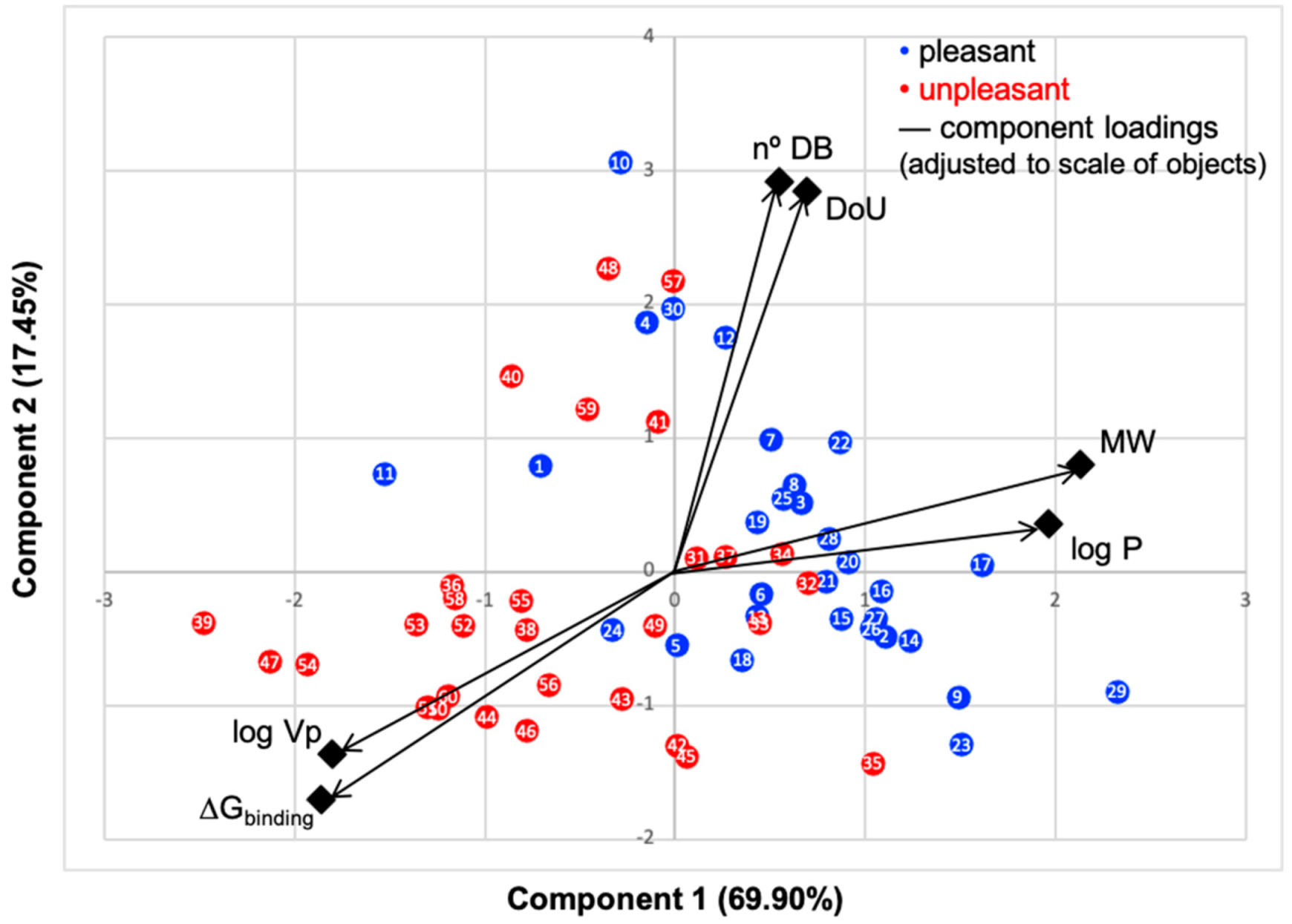

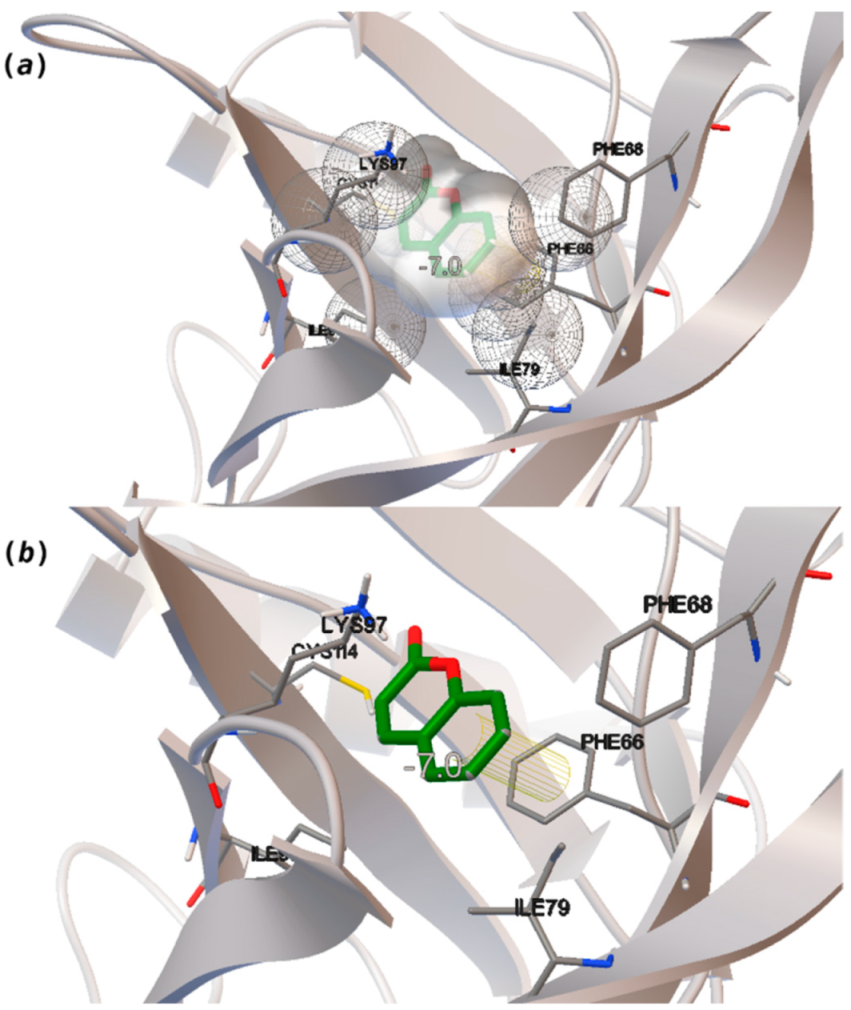
| Formula | Name and Odor Description | MW (g/mol) | log P | Vp (mmHg) | nº DB | DoU | ΔGbinding (kcal/mol) | |
|---|---|---|---|---|---|---|---|---|
| 1 | 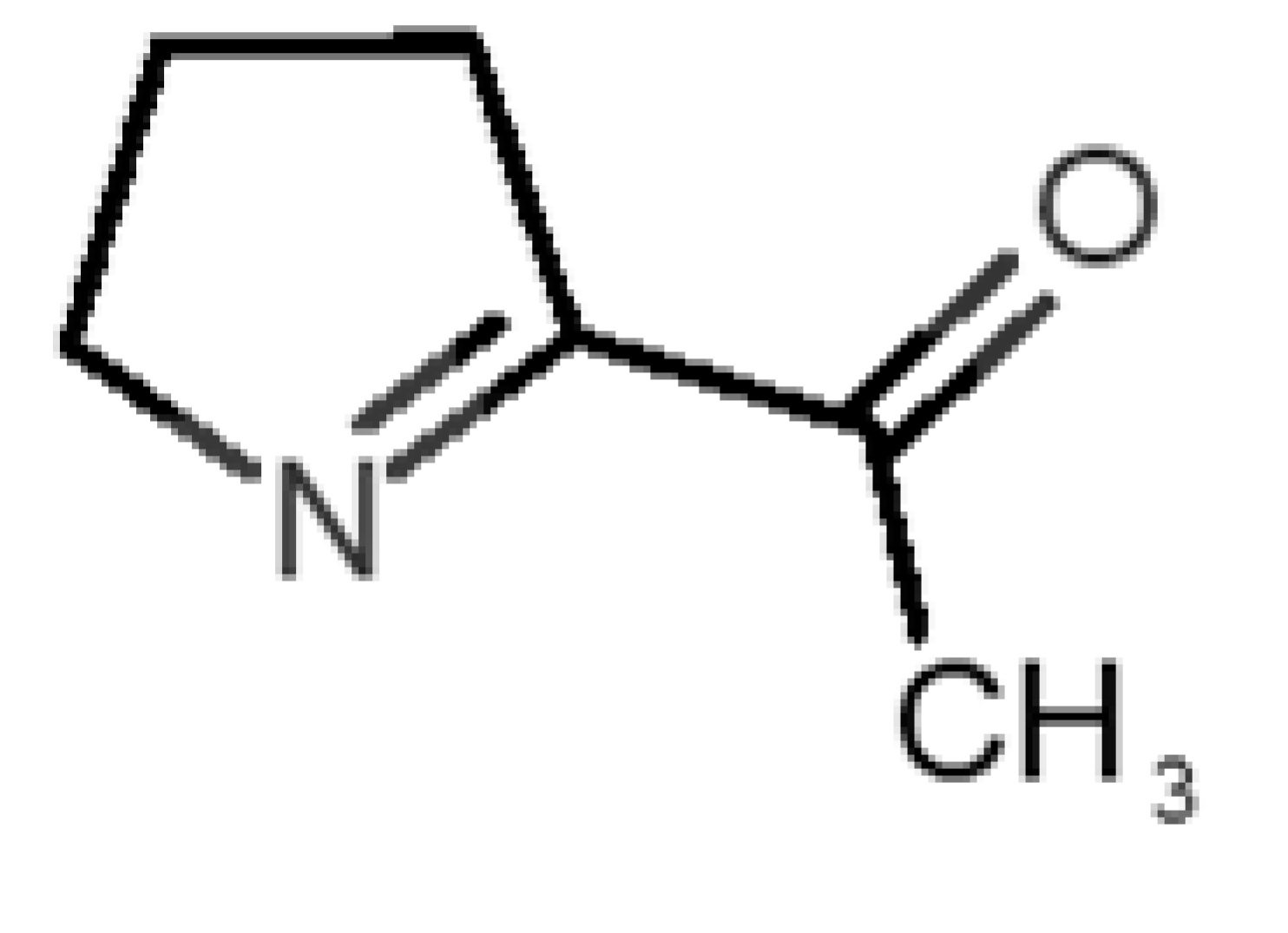 | 2-acetyl-1-pyrroline (roasted/bread) | 111.14 | −0.02 | 0.793 | 2 | 3 | −4.5 |
| 2 |  | α-terpineol (lilac) | 154.25 | 2.98 | 0.042 | 1 | 2 | −5.9 |
| 3 |  | β-ocimene (sweet herbal) | 136.24 | 4.41 | 1.559 | 3 | 3 | −5.9 |
| 4 |  | benzyl acetate (strawberry/pear) | 150.17 | 1.96 | 0.177 | 4 | 5 | −5.8 |
| 5 | 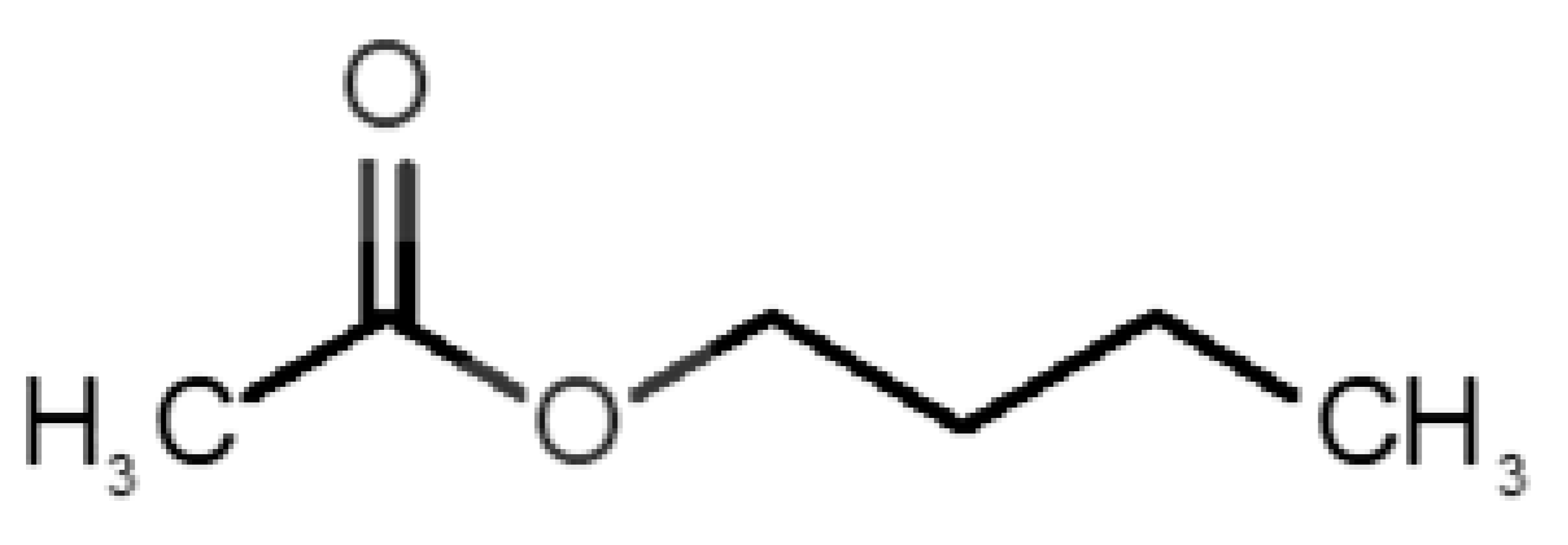 | butyl acetate (banana) | 116.16 | 1.78 | 11.500 | 1 | 1 | −4.1 |
| 6 |  | camphor (camphor) | 152.24 | 2.38 | 0.650 | 1 | 3 | −4.3 |
| 7 |  | carvone (mint) | 150.22 | 3.07 | 0.115 | 3 | 4 | −6.2 |
| 8 |  | citral (lemon/citrus) | 152.24 | 3.17 | 0.091 | 3 | 3 | −5.9 |
| 9 |  | citronellol (citronella/rose-like) | 156.27 | 3.91 | 0.020 | 1 | 1 | −5.7 |
| 10 | 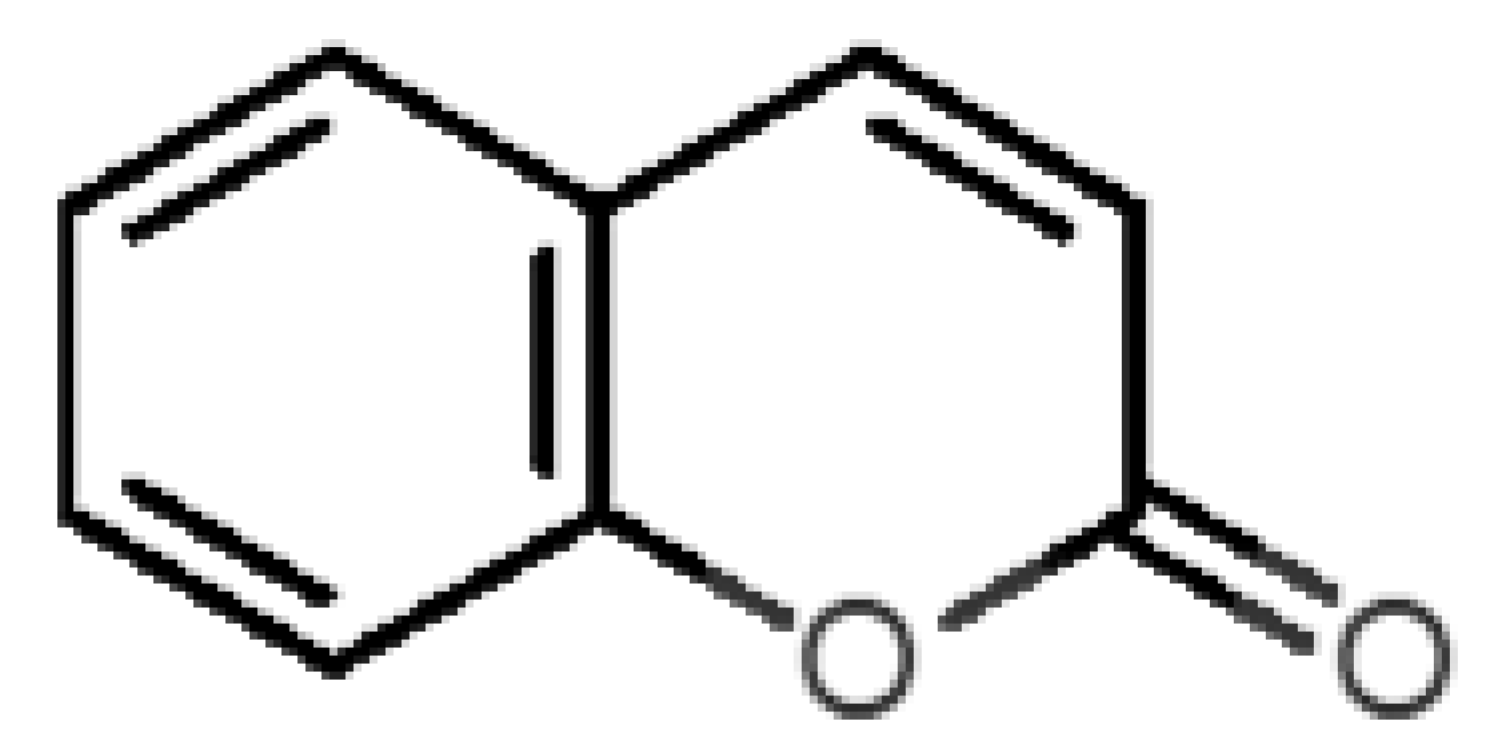 | coumarin (sweet vanilla) | 146.15 | 1.39 | 0.001 | 5 | 7 | −7.0 |
| 11 | 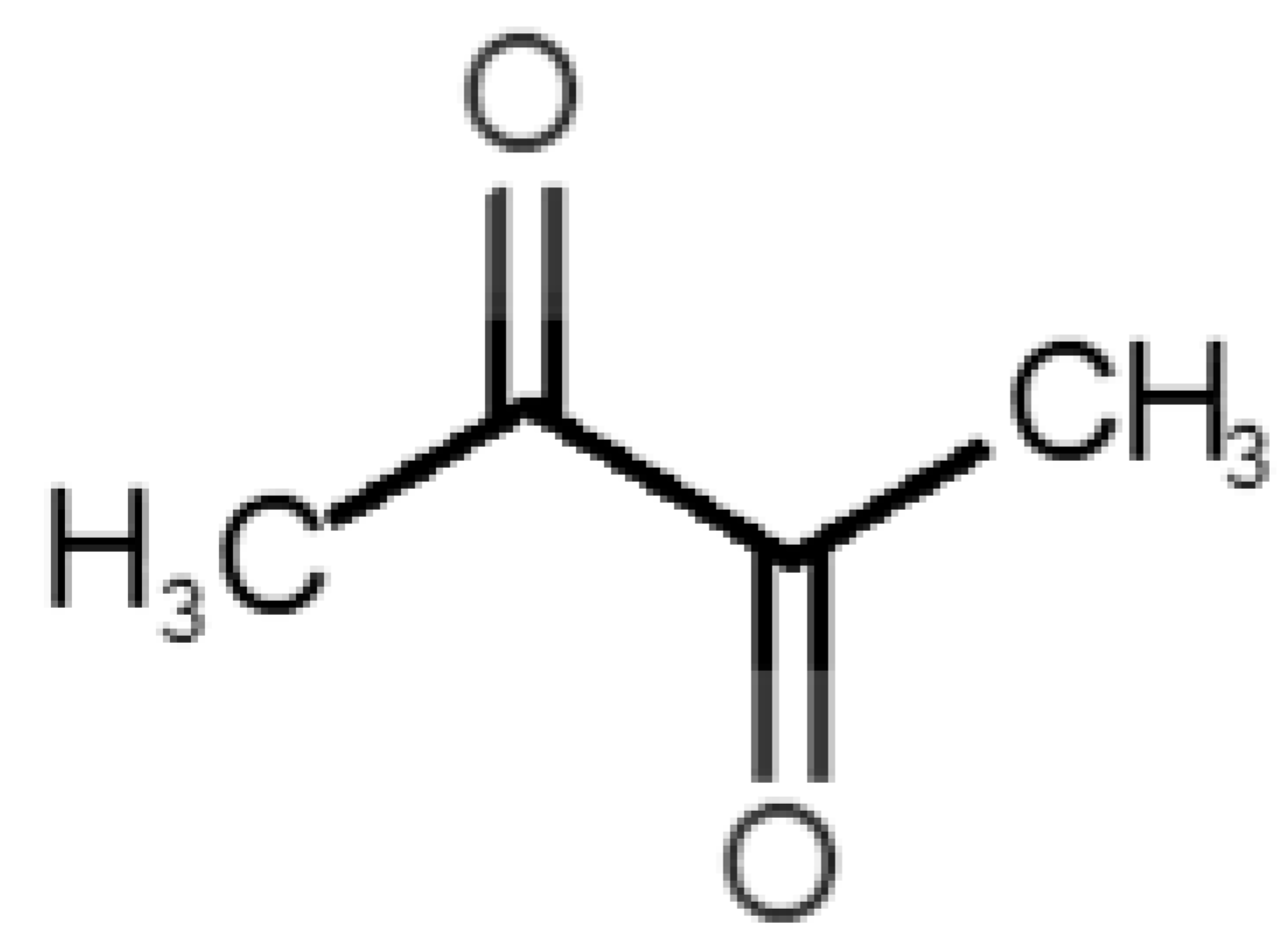 | diacetyl (buttery) | 86.09 | −1.34 | 56.800 | 2 | 2 | −3.6 |
| 12 |  | eugenol (cloves) | 164.20 | 2.49 | 0.022 | 4 | 5 | −6.1 |
| 13 | 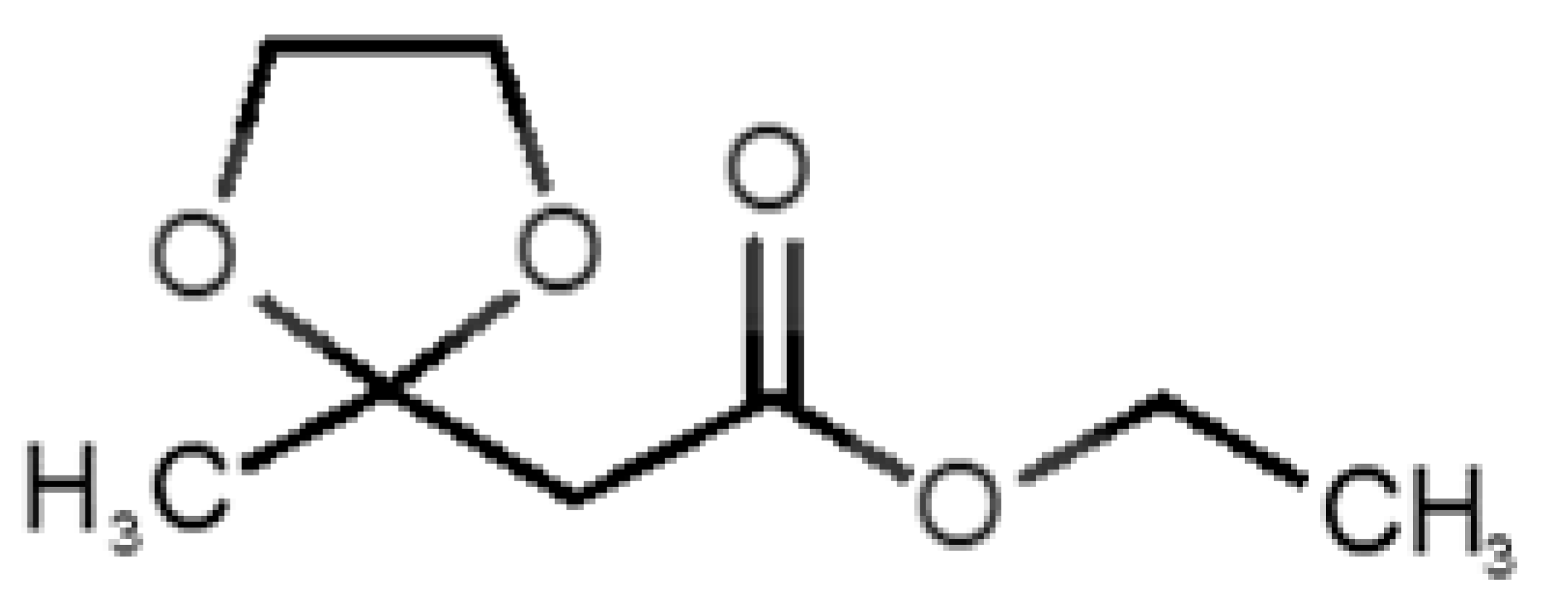 | fructone (apple) | 174.19 | 0.98 | 0.219 | 1 | 2 | −4.2 |
| 14 |  | gamma decalactone (coconut) | 170.25 | 2.72 | 0.005 | 1 | 2 | −5.5 |
| 15 |  | gamma nonalactone (peach/fruity) | 156.23 | 1.94 | 0.009 | 1 | 2 | −5.5 |
| 16 |  | geraniol (floral/sweet rose) | 154.24 | 3.56 | 0.030 | 2 | 2 | −5.8 |
| 17 |  | hedione (floral/jasmine) | 226.32 | 2.65 | 0.001 | 2 | 3 | −6.2 |
| 18 |  | isoamyl acetate (pear/banana) | 130.19 | 2.26 | 5.600 | 1 | 1 | −4.5 |
| 19 | 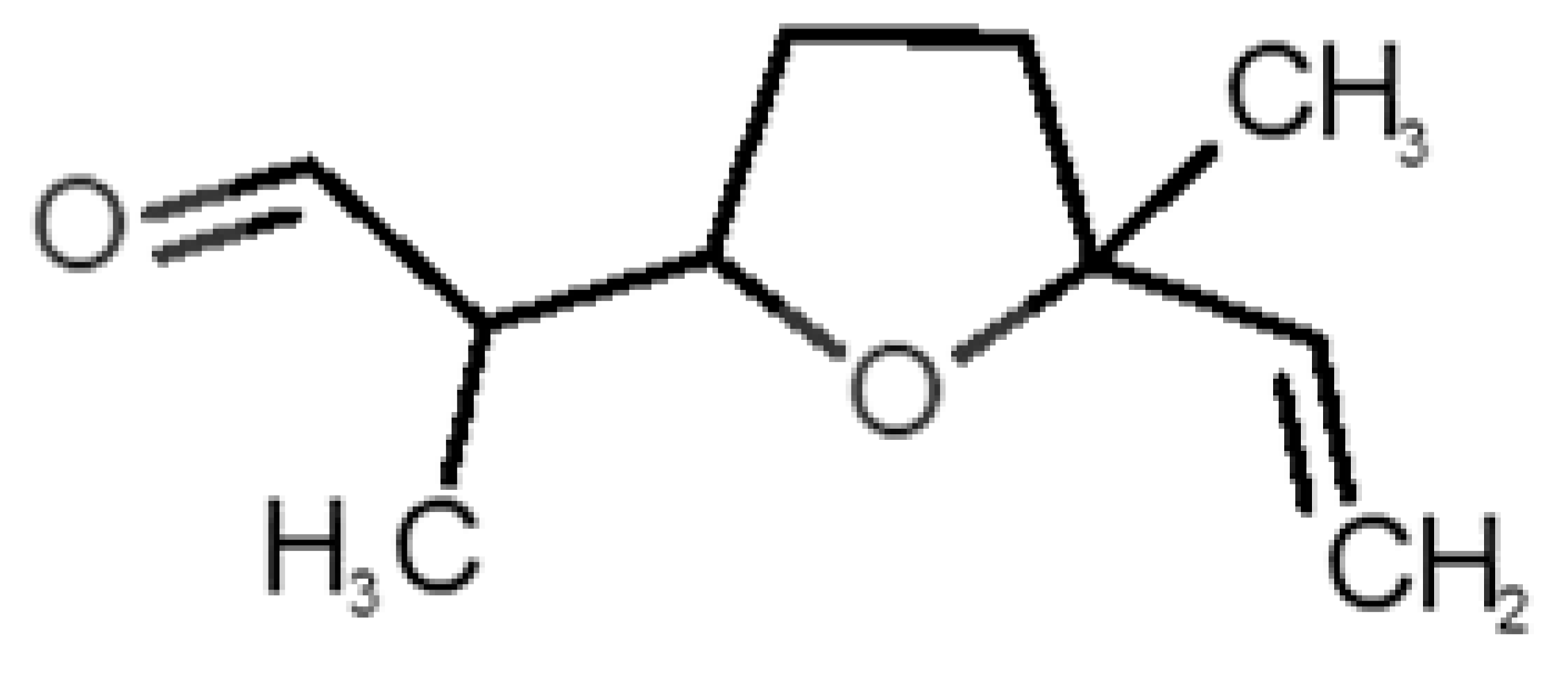 | lilac aldehyde (floral/lilac) | 168.24 | 1.59 | 0.100 | 2 | 3 | −5.2 |
| 20 | 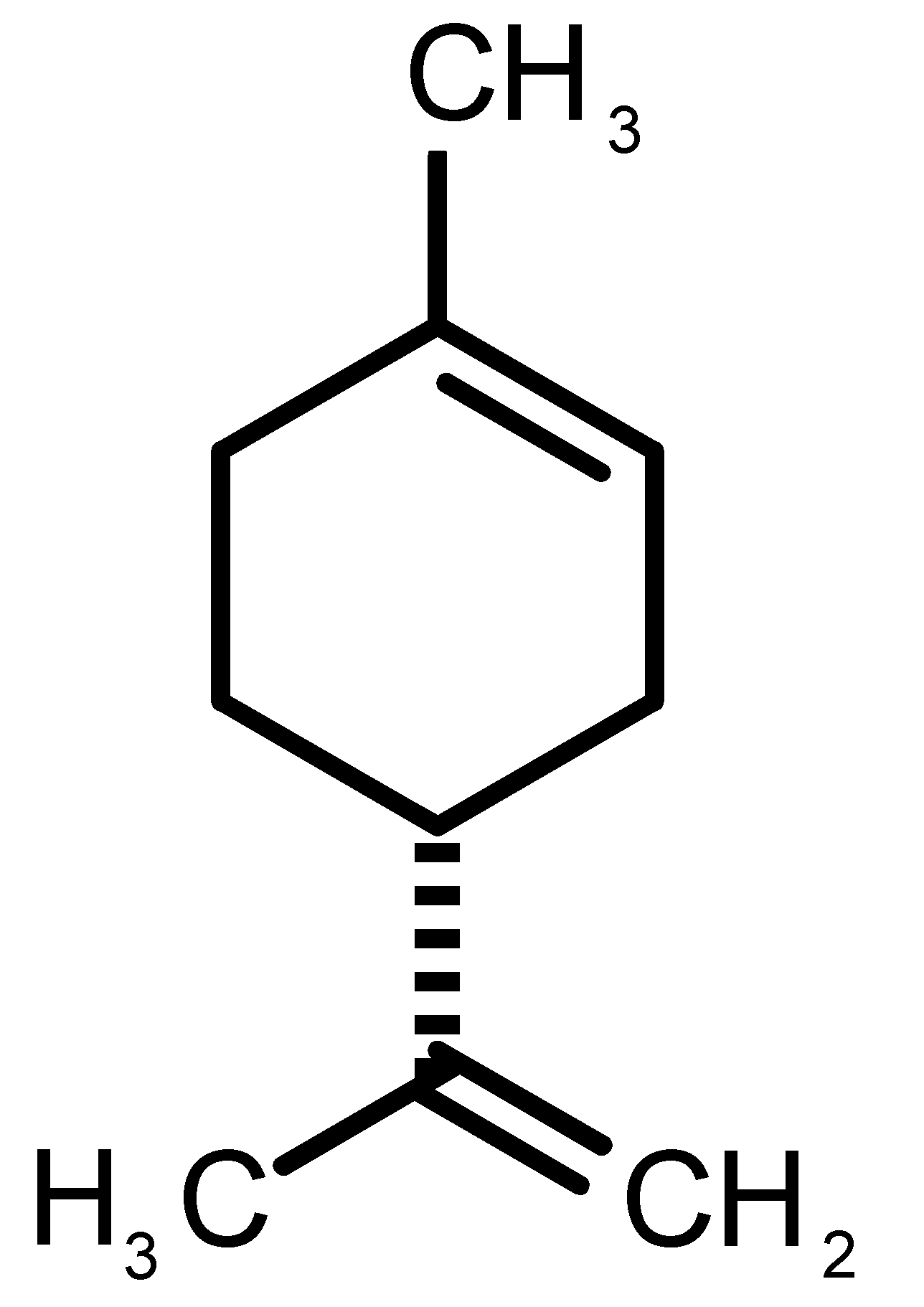 | limonene (citric) | 136.23 | 4.57 | 1.550 | 2 | 3 | −6.1 |
| 21 |  | linalool (lavender/bergamot) | 154.25 | 2.97 | 0.160 | 2 | 2 | −5.5 |
| 22 |  | mefrosol (floral/rose) | 178.27 | 2.70 | 0.006 | 3 | 4 | −6.6 |
| 23 |  | menthol (peppermint) | 156.26 | 3.40 | 0.032 | 0 | 1 | −5.7 |
| 24 |  | methyl butyrate (apple/pineapple) | 102.13 | 1.29 | 32.300 | 1 | 1 | −3.9 |
| 25 |  | myrcene (herbal/woody) | 136.24 | 4.17 | 2.290 | 3 | 3 | −5.8 |
| 26 |  | pinene (pine) | 136.24 | 4.83 | 4.750 | 1 | 3 | −5.6 |
| 27 |  | pomarose (plums/apples rose) | 166.26 | 2.68 | 0.048 | 2 | 1 | −5.9 |
| 28 | 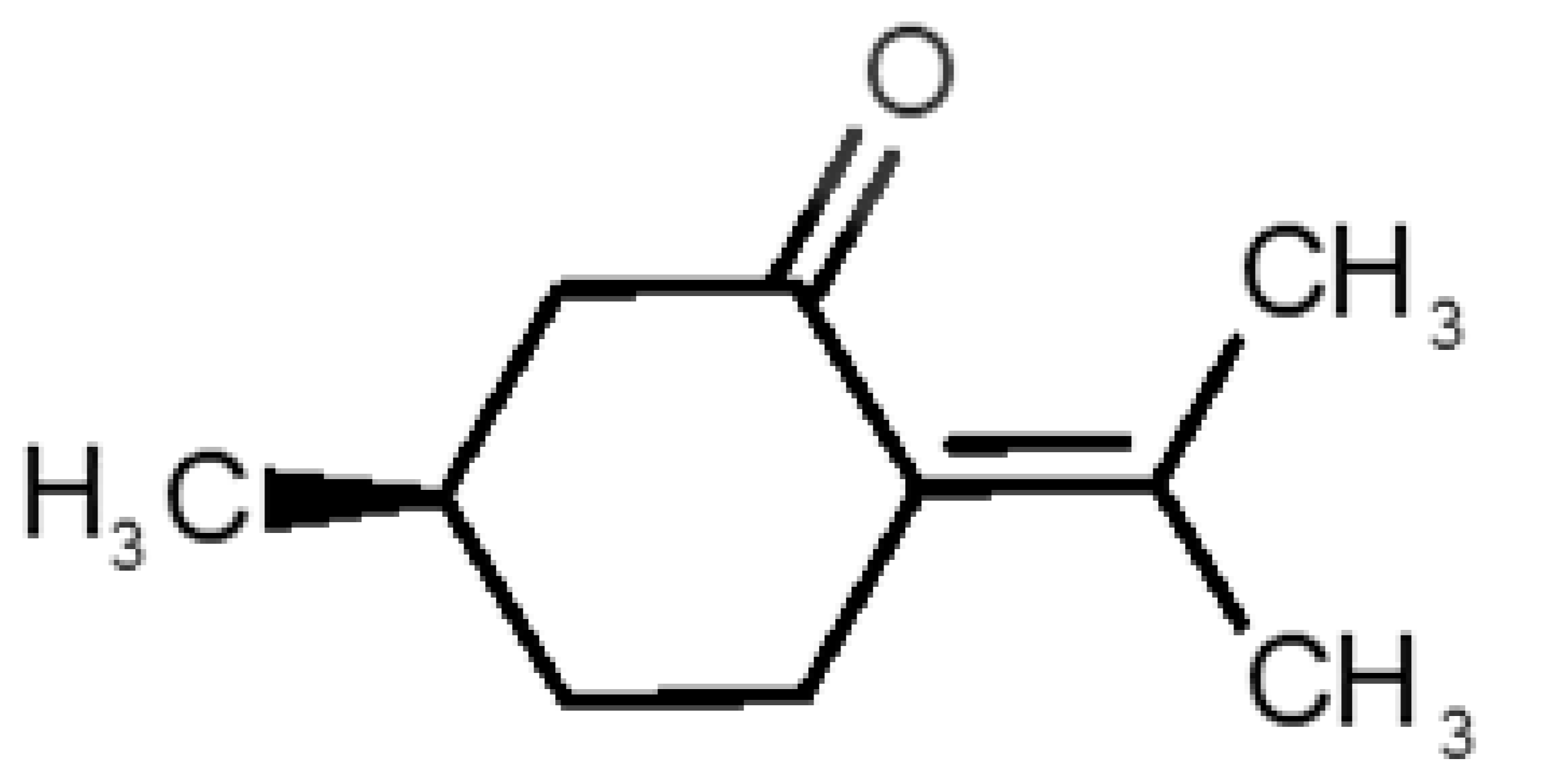 | pulegone (peppermint) | 152.24 | 3.08 | 0.123 | 2 | 3 | −6.2 |
| 29 | 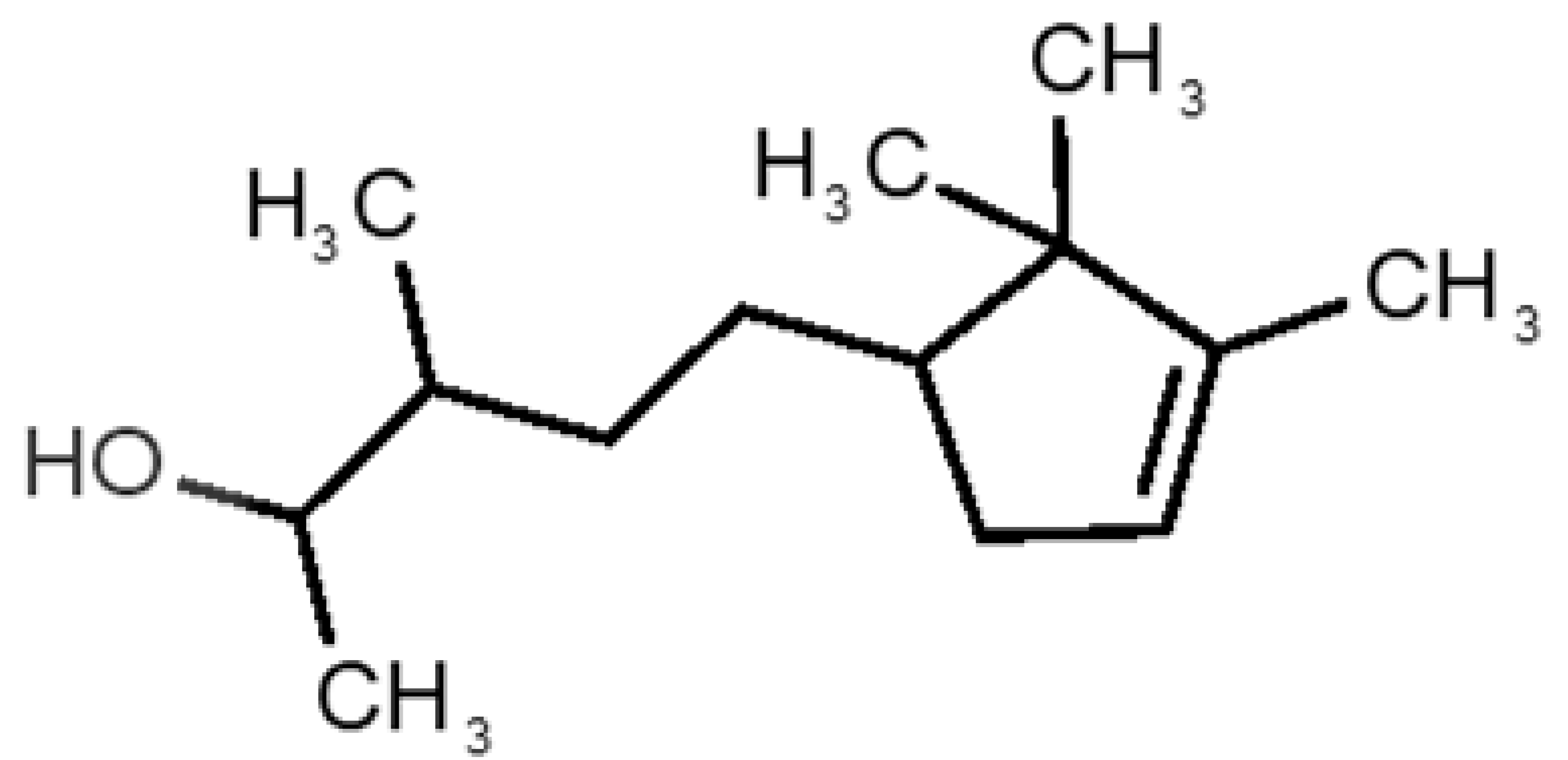 | sandalore (sandalwood) | 210.36 | 4.58 | 0.001 | 1 | 2 | −6.6 |
| 30 |  | vanillin (vanilla) | 152.15 | 1.21 | 0.000 | 4 | 5 | −5.3 |
| Formula | Name and Odor Description | MW (g/mol) | log P | Vp (mmHg) | nº DB | DoU | ΔGbinding (kcal/mol) | |
|---|---|---|---|---|---|---|---|---|
| 31 |  | 1-octen-3-one (metallic mushroom/blood) | 126.20 | 2.18 | 1.063 | 2 | 2 | −4.6 |
| 32 |  | 2-nonenal (aging body/fatty) | 140.22 | 3.32 | 0.256 | 2 | 2 | −5.2 |
| 33 |  | 3-hydroxy-3-methylhexanoic acid (axillary sweat/cumin) | 146.18 | 0.27 | 0.001 | 1 | 1 | −4.7 |
| 34 |  | 3-methyl-2-hexenoic acid (axillary sweathircine (goat)) | 128.17 | 2.20 | 0.001 | 2 | 2 | −5.0 |
| 35 |  | 3-methyl-3-sulfanyl-hexanol (axillary sweat/onion) | 148.27 | 2.15 | 0.023 | 0 | 0 | −4.3 |
| 36 | 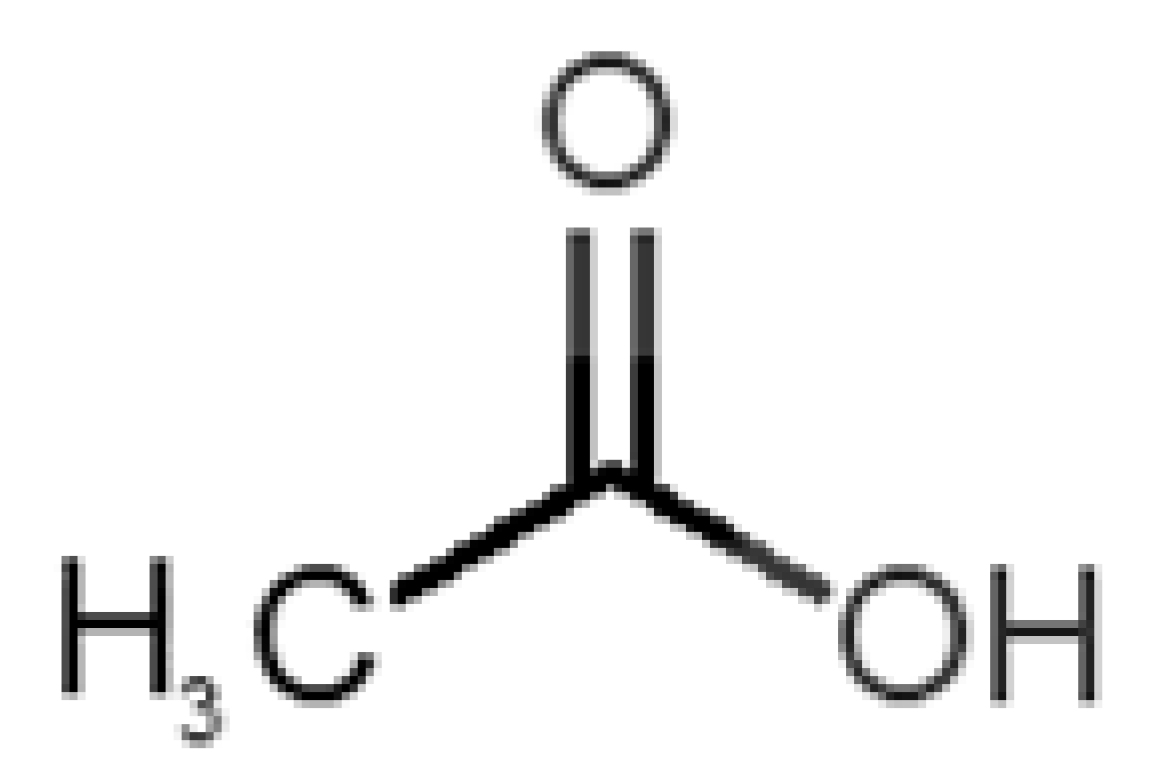 | acetic acid (vinegar-like/pungent) | 60.05 | −0.17 | 15.730 | 1 | 1 | −3.0 |
| 37 |  | allicin (garlic-like) | 162.27 | 1.13 | 0.038 | 2 | 2 | −4.1 |
| 38 |  | allylthiol (garlic/sulfurous) | 74.14 | 1.51 | 151.700 | 1 | 1 | −2.6 |
| 39 |  | ammonia (pungent/sharp) | 17.03 | −2.66 | 7500 | 0 | 0 | −1.4 |
| 40 | 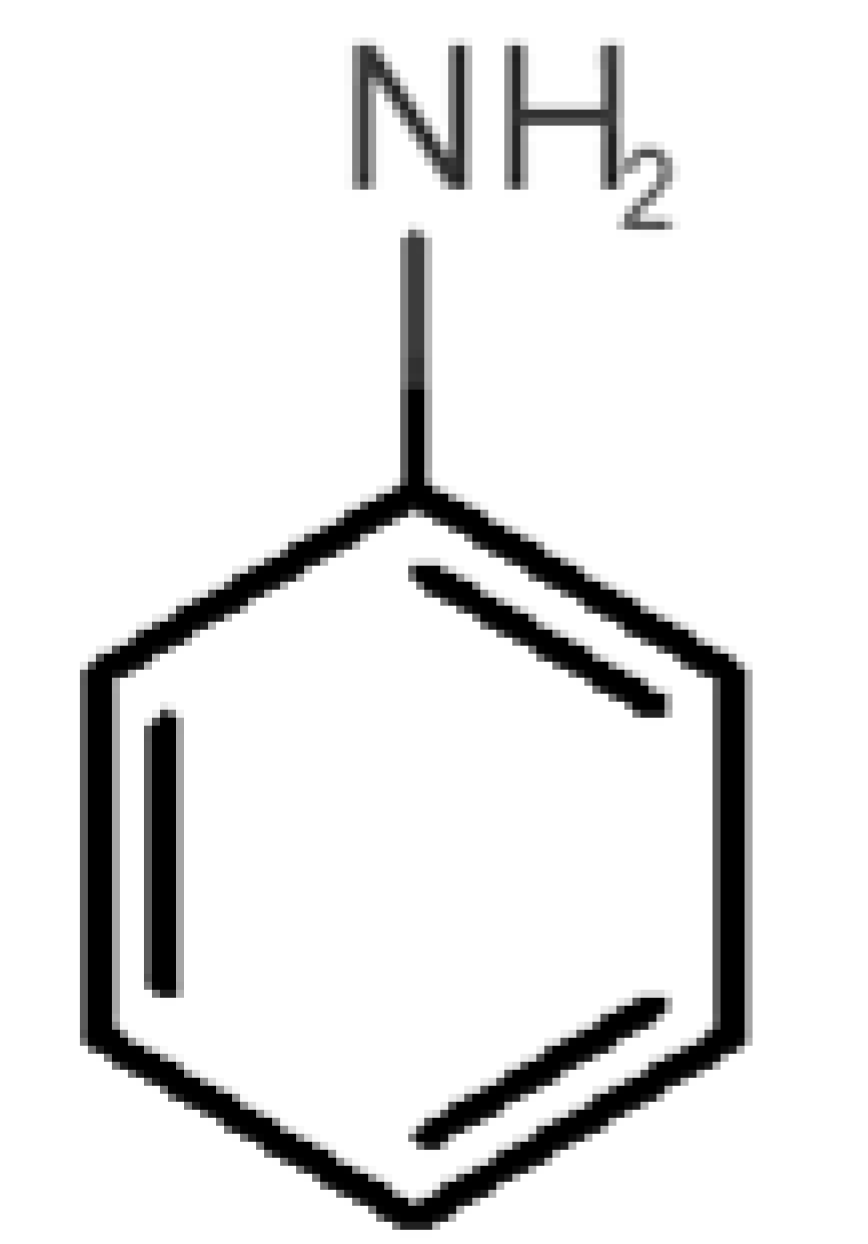 | aniline (rotten fish) | 93.13 | 0.9 | 0.667 | 3 | 4 | −4.8 |
| 41 |  | benzyl mercaptan (unpleasant, strong) | 124.20 | 2.5 | 0.470 | 3 | 4 | −5.2 |
| 42 |  | butyl mercaptan (skunk) | 90.18 | 2.28 | 45.500 | 0 | 0 | −3.3 |
| 43 |  | cadaverine (semen/vagina infection) | 102.18 | −0.16 | 1.010 | 0 | 0 | −3.6 |
| 44 |  | chlorine (pungent/irritating) | 70.90 | 0.85 | 5830 | 0 | 0 | −1.9 |
| 45 |  | chloroform (ether-like/pungent) | 119.37 | 1.97 | 197 | 0 | 0 | −2.9 |
| 46 | 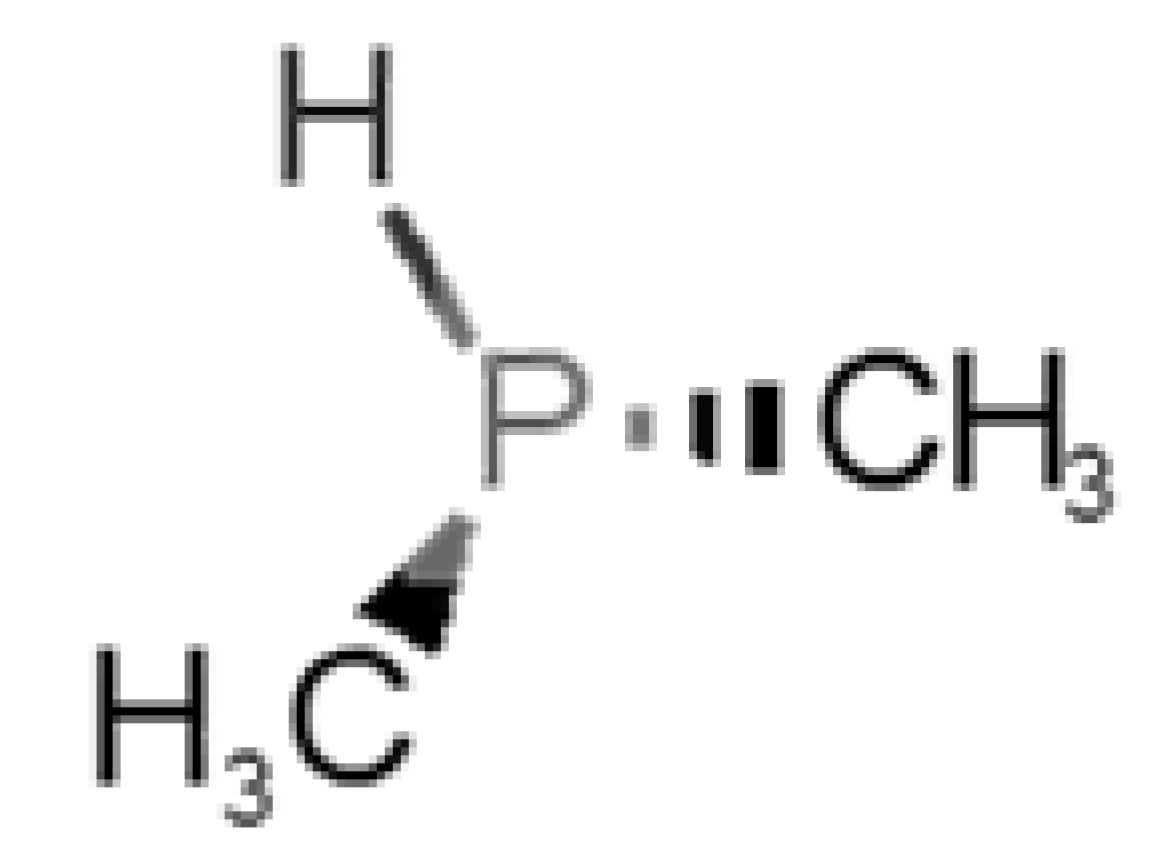 | dimethylphosphine (metallic/fish/garlic) | 62.05 | 1.67 | 760 | 0 | 0 | −1.6 |
| 47 | 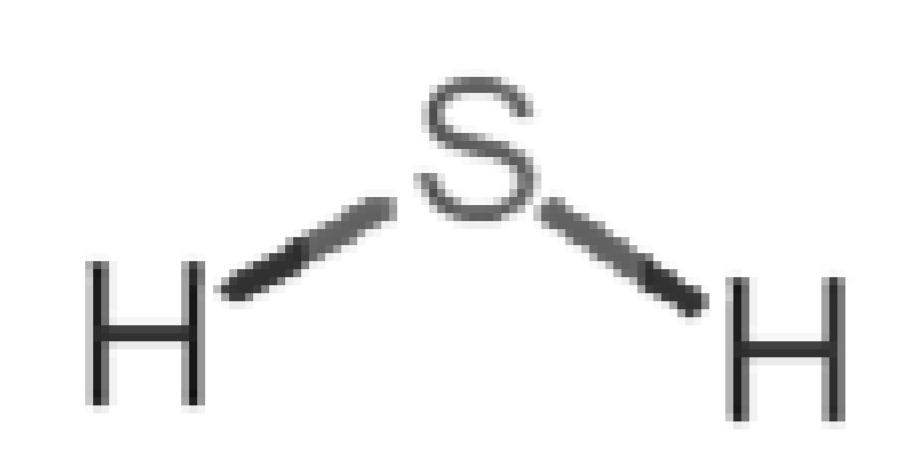 | hydrogen sulfide (rotten eggs) | 34.08 | −1.38 | 13,376 | 0 | 0 | −0.6 |
| 48 |  | indole (feces) | 117.15 | 2.14 | 0.0122 | 4 | 6 | −5.9 |
| 49 | 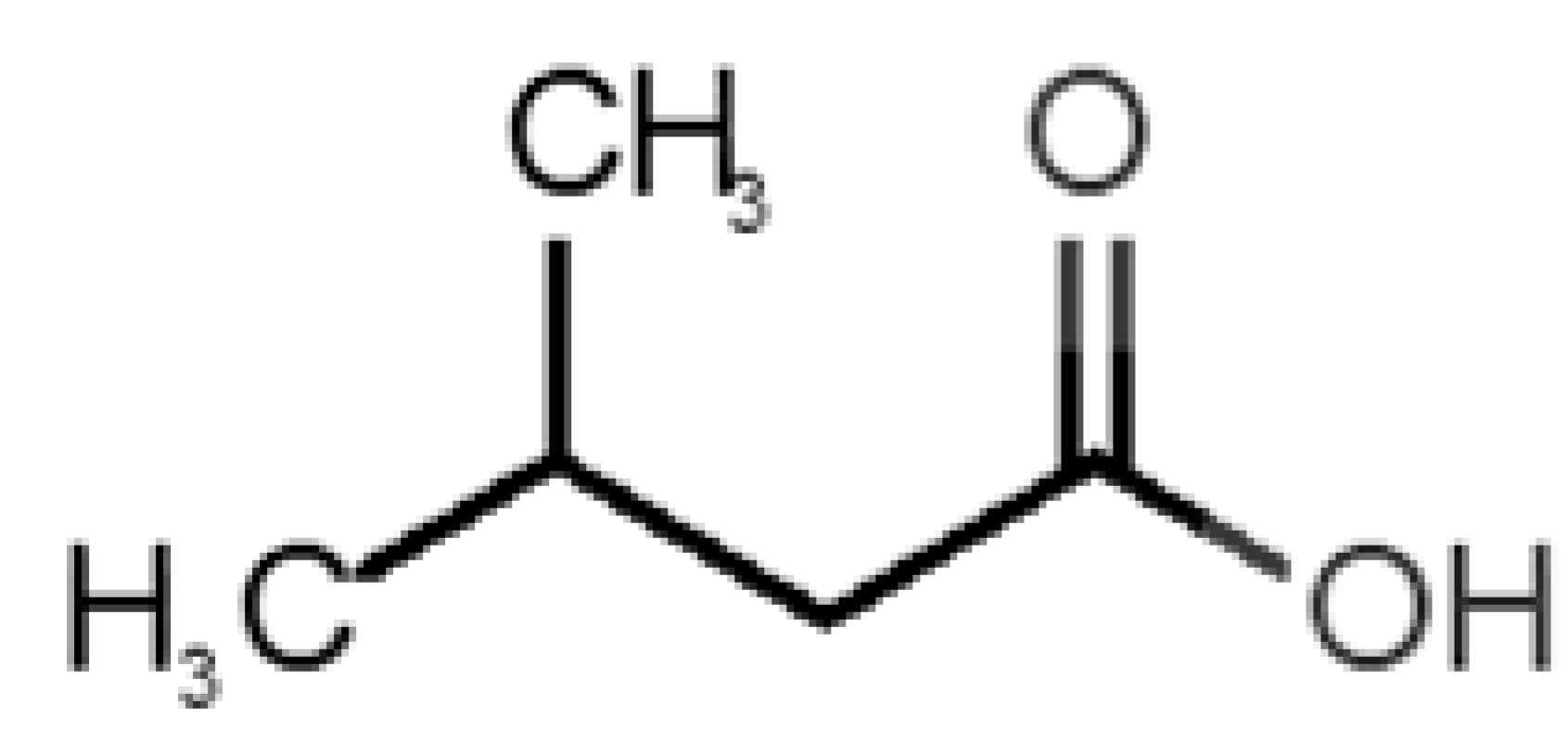 | isovaleric acid (cheesy/sweaty/foot) | 102.13 | 1.16 | 0.440 | 1 | 1 | −4.1 |
| 50 | 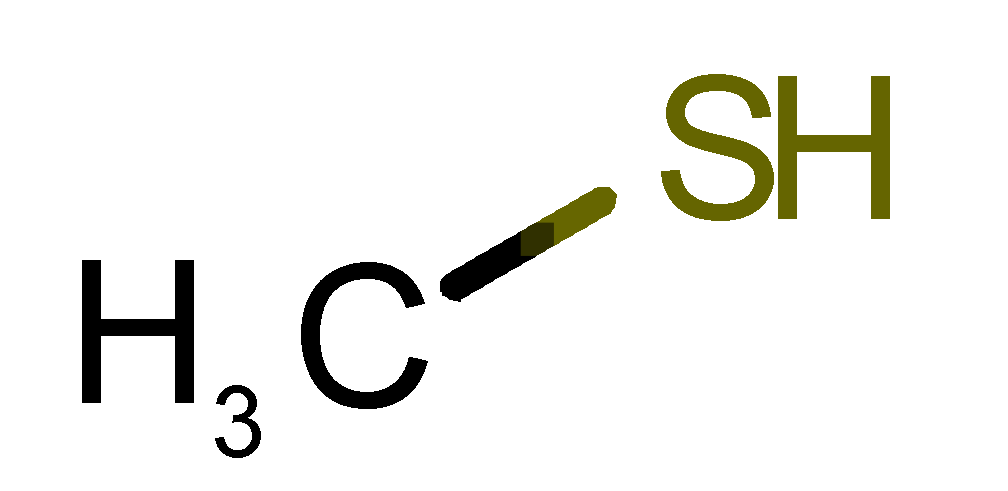 | methanethiol (rotten cabbage/flatulence) | 48.11 | 0.78 | 1510 | 0 | 0 | −1.1 |
| 51 |  | methylphosphine (fish-like/garlic-like) | 48.02 | 0.70 | 2812.800 | 0 | 0 | −1.1 |
| 52 | 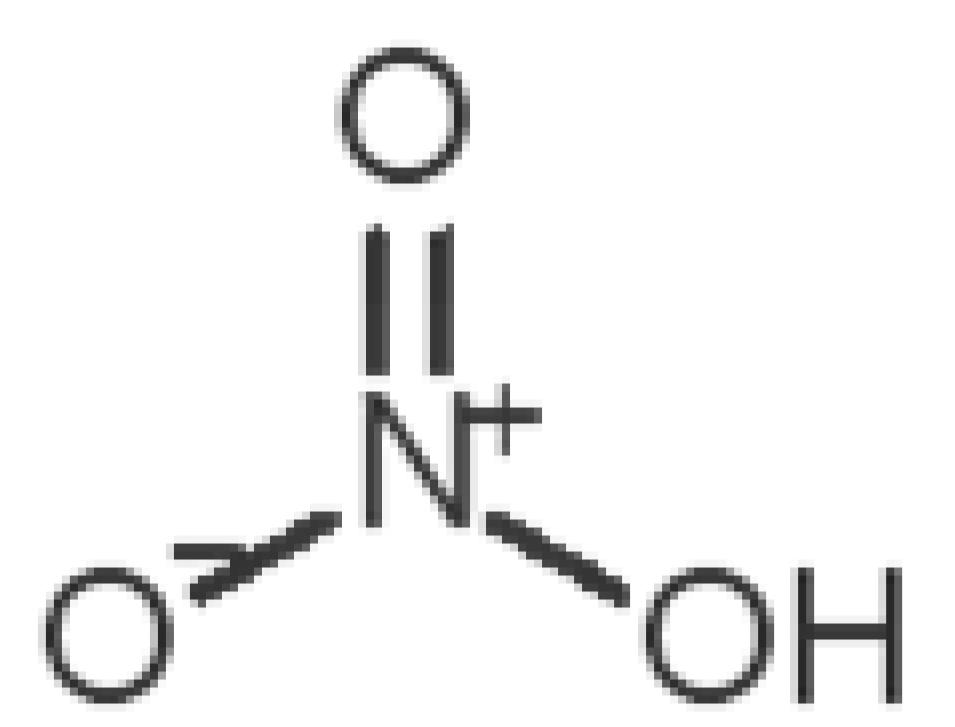 | nitric acid (acrid/suffocating) | 63.013 | −0.21 | 63.100 | 1 | 0 | −3.1 |
| 53 |  | nitrogen dioxide (pungent/acrid) | 46.006 | 0.06 | 720 | 1 | 0.5 | −2.8 |
| 54 | 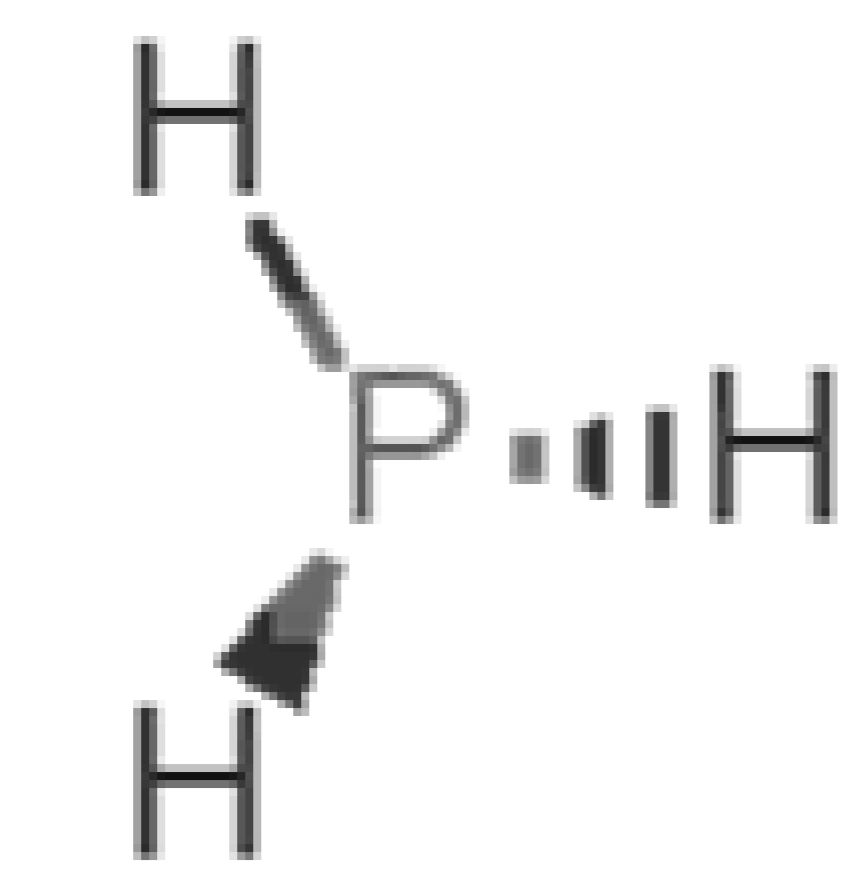 | phosphine (rotten fish/garlic) | 33.99 | −0.27 | 29,300 | 0 | 0 | −0.6 |
| 55 | 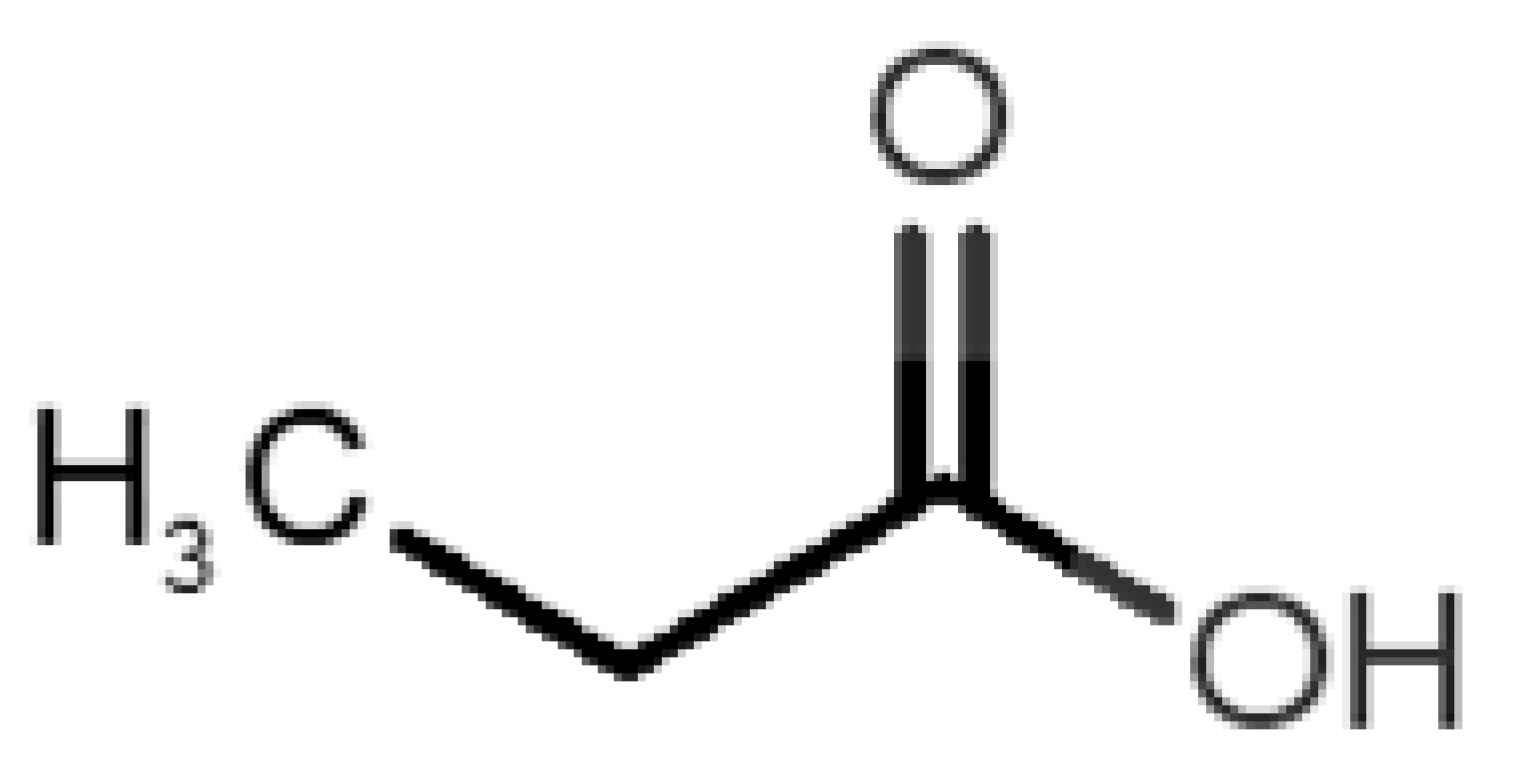 | propanoic acid (foot/sharp rancid) | 74.08 | 0.33 | 3.530 | 1 | 1 | −3.2 |
| 56 |  | putrescine (putrefying flesh) | 88.15 | −0.7 | 2.330 | 0 | 0 | −3.1 |
| 57 | 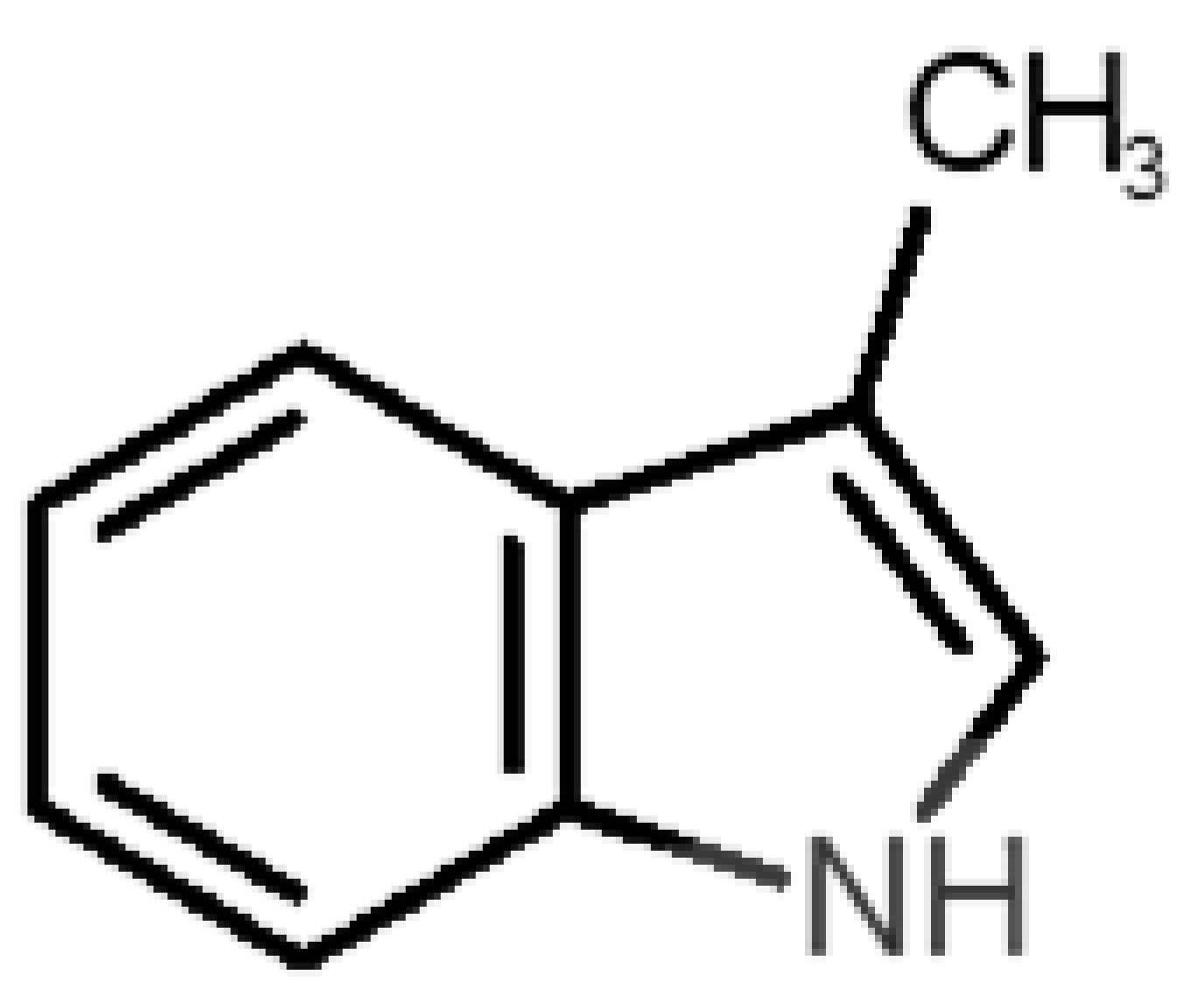 | skatole (feces) | 131.17 | 2.6 | 0.010 | 4 | 6 | −6.5 |
| 58 | 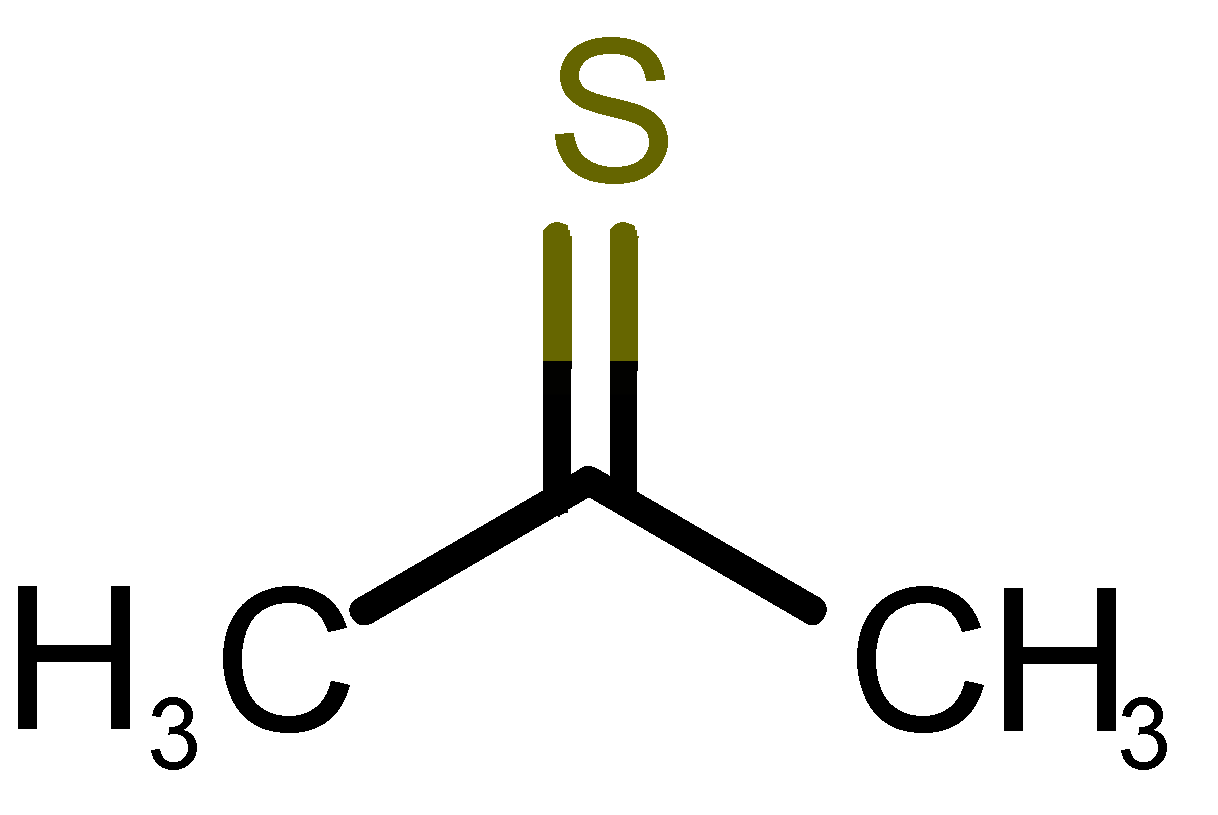 | thioacetone (putrid) | 74.15 | 0.05 | 211.500 | 1 | 1 | −2.8 |
| 59 | 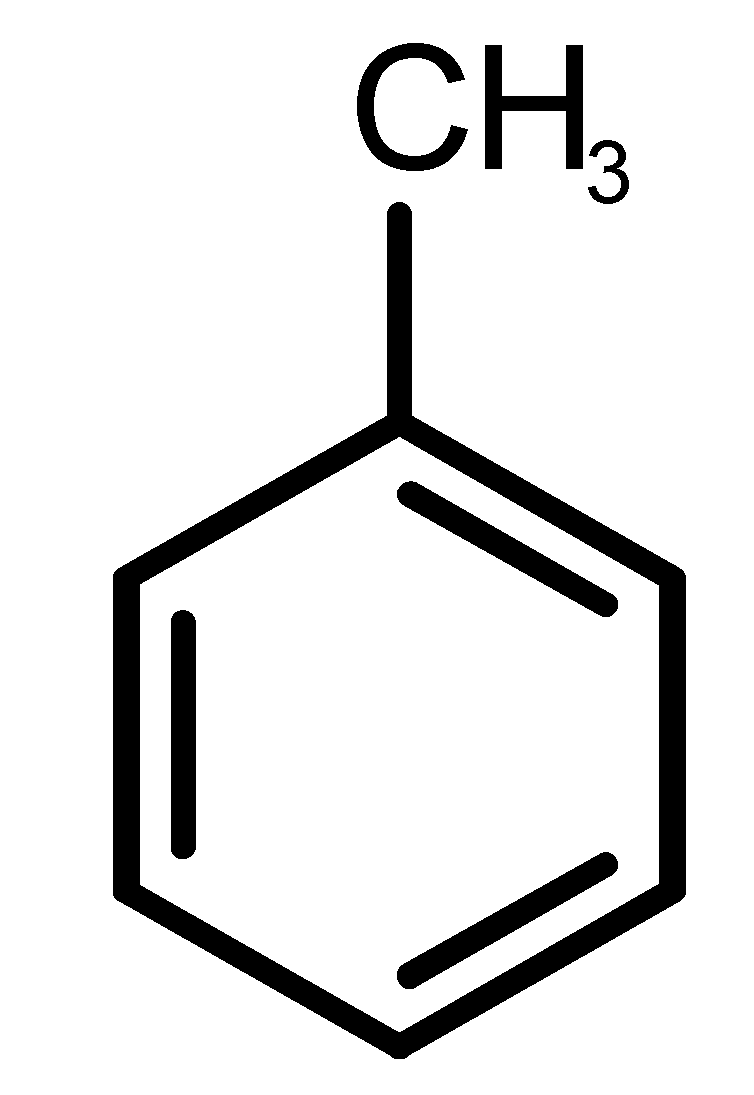 | toluene (paint-thinner/pungent) | 92.14 | 2.73 | 28.400 | 3 | 4 | −5.7 |
| 60 |  | trimethylamine (fishy/ammoniacal) | 59.11 | 0.16 | 1610 | 0 | 0 | −2.0 |
Publisher’s Note: MDPI stays neutral with regard to jurisdictional claims in published maps and institutional affiliations. |
© 2021 by the authors. Licensee MDPI, Basel, Switzerland. This article is an open access article distributed under the terms and conditions of the Creative Commons Attribution (CC BY) license (http://creativecommons.org/licenses/by/4.0/).
Share and Cite
Castro, T.G.; Silva, C.; Matamá, T.; Cavaco-Paulo, A. The Structural Properties of Odorants Modulate Their Association to Human Odorant Binding Protein. Biomolecules 2021, 11, 145. https://doi.org/10.3390/biom11020145
Castro TG, Silva C, Matamá T, Cavaco-Paulo A. The Structural Properties of Odorants Modulate Their Association to Human Odorant Binding Protein. Biomolecules. 2021; 11(2):145. https://doi.org/10.3390/biom11020145
Chicago/Turabian StyleCastro, Tarsila G., Carla Silva, Teresa Matamá, and Artur Cavaco-Paulo. 2021. "The Structural Properties of Odorants Modulate Their Association to Human Odorant Binding Protein" Biomolecules 11, no. 2: 145. https://doi.org/10.3390/biom11020145







